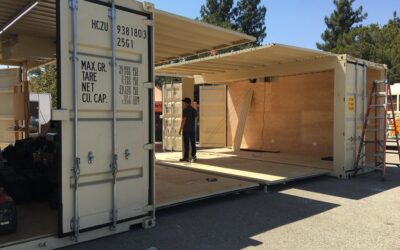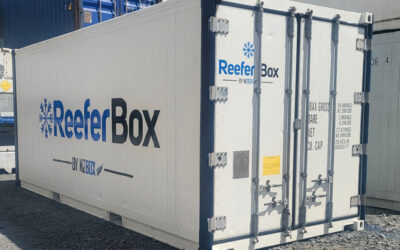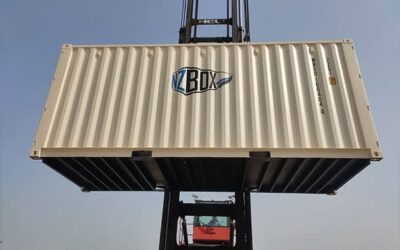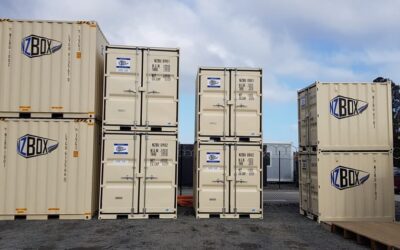Shipping containers, once solely associated with global trade, are experiencing a remarkable transformation. Their durability and versatility have made them a compelling choice for a wide range of applications, from homes and offices to retail spaces and disaster relief shelters. But beyond their practical benefits, shipping containers are also emerging as a powerful tool for environmental sustainability.
In this post, we will explore how shipping containers can contribute to a greener future through eco-friendly architecture and sustainable practices.
The Environmental Impact of Shipping Containers vs. Traditional Building Materials
Shipping containers offer a significant environmental advantage over traditional building materials like concrete and wood. One of the primary benefits is the production process. Unlike concrete and wood, which require substantial energy and resources to extract and manufacture, shipping containers are designed for durability and longevity from the outset. This inherent resilience reduces the need for constant replacement, resulting in lower associated environmental impacts.
A study by the World Shipping Council found that the global shipping industry has made significant strides in reducing its carbon footprint. Initiatives focused on fuel efficiency, vessel design, and operational optimisation are clear indicators of the industry’s commitment to sustainability. Although challenges remain, the progress is encouraging and aligns with broader environmental goals.
Reusing and Repurposing Shipping Containers
The environmental impact of shipping containers becomes even more compelling when considering their potential for reuse and repurposing. Instead of ending up in landfills, these robust structures can be given new life as homes, offices, retail spaces, and more. By extending the lifespan of shipping containers, we conserve resources and reduce the demand for new materials.
According to the Container Recycling Institute, there are over 40 million shipping containers worldwide. This represents a vast pool of potential building materials that can be diverted from landfills and repurposed into sustainable solutions. By tapping into this resource, we can significantly decrease the environmental burden associated with constructing new buildings from scratch.
Energy Efficiency and Sustainability Features
Shipping container buildings can be designed with a strong emphasis on energy efficiency. Their enclosed structure provides excellent insulation, which reduces the need for heating and cooling. Incorporating sustainable features like solar panels, rainwater harvesting systems, and green roofs can further enhance the environmental performance of these structures.
A study by the Lawrence Berkeley National Laboratory found that well-insulated shipping container homes can achieve energy efficiency levels comparable to or even exceeding traditional homes. This demonstrates the potential for shipping containers to serve as viable, eco-friendly alternatives to conventional building practices.
Case Studies of Sustainable Shipping Container Projects

Eagleash, CC BY-SA 4.0 <https://creativecommons.org/licenses/by-sa/4.0>, via Wikimedia Commons
Several inspiring projects showcase the potential of shipping containers as sustainable building solutions. These case studies demonstrate the versatility and environmental benefits of this unconventional building material.
The Container City in London
The Container City project transformed abandoned shipping containers into affordable housing units. This initiative highlights the potential of container architecture to address urban housing challenges while promoting sustainability. The repurposed containers provide a unique, eco-friendly solution to the housing crisis, proving that creative thinking can lead to significant environmental benefits.
CarGurus Headquarters
Located in Massachusetts, the CarGurus headquarters repurposed shipping containers to create a modern and sustainable office space. This project showcases the adaptability of shipping containers for commercial applications. By using recycled materials, the company not only saved on construction costs but also demonstrated a commitment to sustainable business practices.
The Boxpark in Shoreditch
Boxpark in Shoreditch, London, is a pop-up mall built entirely from repurposed shipping containers. This innovative retail space offers a vibrant mix of shops, cafes, and event spaces, all within a sustainable framework. The project illustrates how shipping containers can be used creatively to develop eco-friendly commercial environments that engage the community.
Challenges and Misconceptions About Using Shipping Containers for Green Initiatives
While shipping containers offer numerous environmental benefits, there are challenges and misconceptions to address. One common misconception is that converting a shipping container into a habitable or functional space is straightforward. In reality, it requires careful planning, skilled labour, and adherence to building regulations.
Structural Integrity
Shipping containers are designed to withstand heavy loads during transportation, but modifying them for residential or commercial use can affect structural integrity. It’s essential to work with experienced architects and engineers to ensure the container remains safe and stable throughout its use.
Insulation and Ventilation
Another challenge is ensuring adequate insulation and ventilation. Without proper insulation, shipping containers can become extremely hot in summer and cold in winter. Effective ventilation is also crucial to prevent condensation and maintain a comfortable indoor environment. Addressing these issues requires careful design and the use of high-quality materials.
Regulatory Compliance
Navigating building regulations and obtaining necessary permits can be complex when using shipping containers for construction. Regulations vary by location, so it’s essential to research local requirements and work with professionals who understand the legal landscape.
Practical Tips for Incorporating Shipping Containers into Sustainable Projects
Despite the challenges, incorporating shipping containers into sustainable projects is achievable with the right approach. Here are some practical tips to guide the process:
Choose Recycled or Refurbished Containers
Opt for containers with a history of use to reduce the demand for new production. Recycled or refurbished containers are more environmentally friendly and often more affordable than new ones.
Prioritise Energy Efficiency
Implement insulation, ventilation, and renewable energy systems to maximize energy performance. Consider using eco-friendly insulation materials like sheep’s wool or recycled denim, and install solar panels to generate clean energy.
Minimise Waste
Careful planning and efficient construction practices can help reduce waste generation. Design your project with precision to minimize material offcuts, and recycle any leftover materials whenever possible.
Consider the End of Life
Develop plans for the eventual disposal or repurposing of the container to avoid contributing to landfill waste. Think ahead about how the container can be disassembled and reused or recycled at the end of its life cycle.
Conclusion
Shipping containers have immense potential to contribute to a greener future. Their durability, versatility, and adaptability make them ideal for a wide range of sustainable applications. By repurposing and reusing these structures, we can conserve resources, reduce waste, and promote eco-friendly architecture.
For eco-conscious consumers, sustainability enthusiasts, and business owners, shipping containers offer a practical and innovative solution to environmental challenges. By integrating shipping containers into sustainable projects, we can collectively work towards a more sustainable and resilient future.
Explore Further
If you’re inspired to incorporate shipping containers into your sustainable initiatives, talk to the team at NZBOX today and learn more about our range of shipping containers for sale and hire. With expert guidance and a commitment to sustainability, you can transform these versatile structures into functional and eco-friendly spaces. We have both new and used containers for sale and hire in a huge range of sizes from our smallest 6ft shipping container all the way up to 40ft containers. We also have a range of specialised containers including high cube, open side, dangerous goods, and reefer containers.
By exploring the possibilities of shipping container sustainability, we can build a greener world—one container at a time.
Frequently Asked Questions
How are shipping containers more environmentally friendly than traditional building materials?
Shipping containers are considered more eco-friendly than traditional materials like concrete and wood because they require far less energy and resources to produce. Since they’re originally designed to be durable and long-lasting, their reuse reduces the environmental impact associated with manufacturing new materials for construction projects.
What makes reusing and repurposing shipping containers a sustainable choice?
Reusing and repurposing shipping containers helps keep them out of landfills and gives them a second life as homes, offices, or retail spaces. With over 40 million containers in circulation globally, repurposing even a small percentage can significantly reduce the demand for new building materials and help conserve natural resources.
Are shipping container buildings energy-efficient?
Yes, shipping container structures can be highly energy-efficient when properly designed. Their enclosed structure allows for effective insulation, which reduces heating and cooling needs. When combined with eco-friendly features like solar panels, rainwater harvesting, and green roofs, these spaces can meet or even exceed the energy efficiency of traditional buildings.
What are some challenges in using shipping containers for sustainable construction?
While shipping containers offer sustainability benefits, challenges do exist. Modifying them safely requires skilled labour to maintain structural integrity, and achieving proper insulation and ventilation is crucial to prevent extreme temperatures and condensation. Additionally, navigating building regulations can be complex, so working with professionals is essential.
What tips should I follow when using shipping containers for green building projects?
To successfully integrate shipping containers into sustainable projects, it’s recommended to choose recycled or refurbished containers, prioritise energy efficiency through insulation and solar power, minimise construction waste with careful planning, and think ahead about how the container can be reused or recycled at the end of its life.









